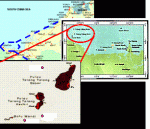Artificial reefs are designed with specific goals
such as to create new habitat on the seafloor for reef
creatures, breeding area, place to seek protection from
predators as well as to provide a substrate for reef
fouling communities, which create a food source for
primary and upper level consumers. Many different
materials have been used to create artificial reefs. In
Talang-Talang Island, a concrete reef ball was used.
Concrete has been found to be very favourable for
artificial reef construction. It does not degrade in
seawater, can be made to have neutral pH, is easily
molded, not easily moved once in place but harder to
transport to the deployment site. Concrete can be made
to have a texture comparable to natural reefs and
develops very similar communities as natural reefs. A
study was carried out at Talang-Talang Islands where
artificial reef (i.e. reef ball) have been deployed
since 1998. This study was carried out to evaluate the
potential of reef ball as a new habitat and its
effectiveness in increasing the productivity of the area
and diversity of fish fauna. The results show that reef
balls that were deployed in 2002 have the highest number
of species (33 species) compared with the nearby natural
reef (26 species). Although the natural reef area have
the highest number of individuals of fish (6,640
individuals) compared with the reef balls (1,631
individuals), reef balls deployed in 2002 have more fish
species of commercial value such as Epinephelus spp.,
Lutjanus spp., Lenthrinus spp., Lates sp., and
Rastrelliger sp. In contrary, the nearby natural reef
have more none commercial species of fish. These results
show that artificial reef is an effective way to
increase fish diversity and increase the number of
commercial fish species.


